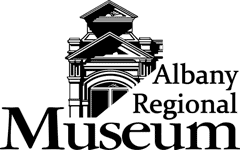By Cathy Ingalls, Albany Regional Museum board member
The Octagon House. Albany Regional Museum photo collection: 2007.015.0377
If you want to know more about why a house at Fifth and Walnut streets in Albany was built in an octagonal shape then visit the Albany Regional Museum, where the history of that house along with nine other Victorian-era residences are on display in a new exhibit.
The story of the houses, photographs of the homes and a photo of the homeowners (always a man) are in frames in the museum’s community room.
Unfortunately, several of the homes are no longer standing.
Volunteers Ruth Alderson and Linda Collins along with staff Keith Lohse, Amy Bozorth, Erica Broad, and Kathwren Hayes did the research on the homes and then arranged and hung the exhibit that will be up probably through July of 2020.
Bozorth said that during the Victorian era, named for Queen Victoria, architects in the American West began to build in the Victorian style in the 1860s and ’70s while modifying plans to make use of materials that were available.
The Octagon House was constructed starting in 1851 for the Rev. James Patterson Millar. In that time, octagonal houses were considered less expensive to build, provided ample living space, and were easier to heat and cool.
Originally, the house was to be a boarding school for girls, but Millar was killed in a steamboat explosion before the school opened.
In 1860, the Rev. Reuben Coleman Hill had the house moved to Second and Washington streets, where it burned down. The fire was thought to have been started by children playing with fireworks.
The Ralston House at 632 Baker St. S.E. was built in 1889 for banker John Ralston in the Eastlake Stick style. Particular features to the home include ornate sunbursts, spool and spindle ornaments and an angled balcony off of the master bedroom.
The Italianate-style Weatherford House at 505 Montgomery St. S.E. was built in 1886 and features a low-hipped roof line with eaves supported by decorative scroll-brackets.
Immigrant and lawyer J.K. Weatherford graduated from Oregon Agricultural College and started a law firm that still operates in Albany. Weatherford Hall on the Oregon State campus is named for him.
The Young House constructed about 1890 at 628 Ferry St. S.W. is of the Queen Anne style with architectural elements that include big chimneys, a large covered porch and tall windows.
Originally, the house contained an ornate leaded glass door, marble washbasins and four fireplaces.
Samuel E. Young was born in Ohio in 1838, eventually moving to Albany, where he became a merchant and the owner of the S.E. Young and Co. store that became the largest mercantile in Albany.
The Italianate-style Howe-Lee House at 1106 Ferry St. S.W. was built in 1885 for William Fortmiller of Fortmiller Brother Furnishings. Later, Dr. Wallace Howe-Lee bought the house. He worked as a registrar, professor and eventually was president of Albany College.
The Schmitt House at 726 Fifth Ave. S.W. was built in 1900 and was called the “wedding cake” home as it was a wedding gift to Alfred and Orpha Schmitt from her parents Mr. and Mrs. L. Finn.
Schmitt moved to Albany in 1897 and for three years was a professor at Albany College and also taught business administration at OAC, and he served on the Albany School Board.
The Queen Anne-style Hamilton House at 928 Ferry St. S.W. was constructed for Lyman and Hettie Hamilton in 1895.
Hamilton was employed at Meier and Frank in Portland before moving to Albany to work for S.E. Young. After Hamilton married Hettie Miller, the couple bought a women’s wear store. When Young’s store went out of business in 1915, Hamilton’s Department Store moved into Young’s former store location.
The Dawson House at 731 Broadalbin St. S.W. was designed by well-known architect Charles Burggraf and built in 1910. The house is now a bed and breakfast and features a ballroom on the third floor.
Alfred Dawson operated the Owl Drug Store at 238 W. First Ave. An owl design appears on the top gable of his home.
The Sox House at 531 Ferry St. S.W. was built for Edward F. Sox, who was a teacher and principal in Albany and later became a partner in the Steward and Sox Hardware Store on Second Street in Albany.
The Blodgett House at Ninth and Washington streets was built in the late 1800s for Newton Alton Blodgett and his wife Mary Jane Sommerville Blodgett.
Originally a two story home, the top floor burned shortly after the turn of the 20th century. The owners replaced the second floor with attic space.
Blodgett operated the Blodgett Flour Mill on Water Street.
The museum is located at 136 Lyon St. S. and is open from 11 a.m. to 4 p.m. Tuesday through Friday and 10 a.m. to 2 p.m. on Saturday.
The phone number is 541-967-7122, and the website address is www.armuseum.com.

